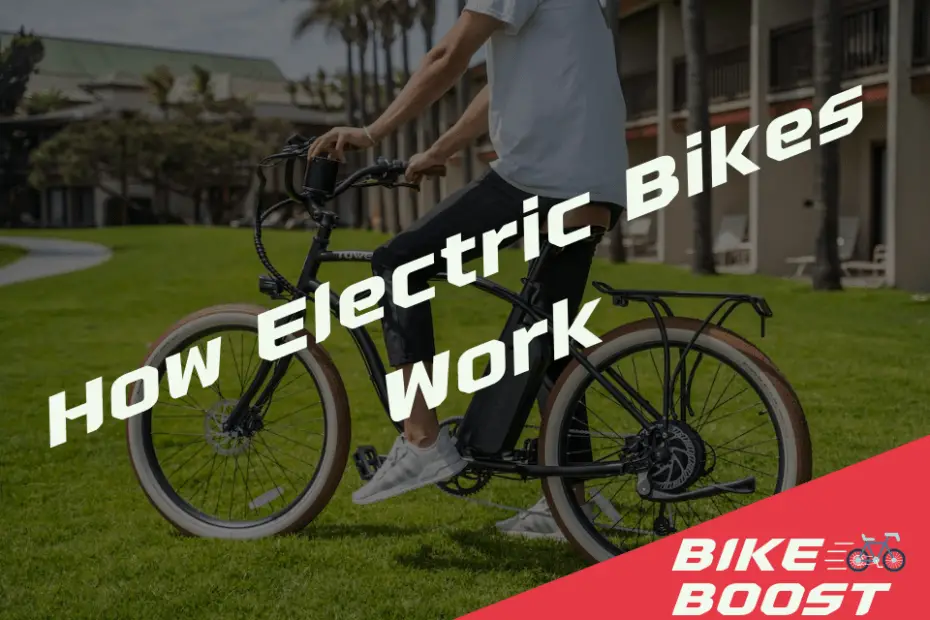We love writing these guides for you and sometimes we are compensated when you use one of our links to buy a product. This doesn’t impact the final price you pay. If you want to learn more about how this works, please see our Affiliate Disclosure page.
When it comes to revolutionizing the world of cycling, electric bikes have taken the lead with their cutting-edge technology and eco-friendly features. If you’ve ever wondered how these electric marvels operate and what sets them apart from traditional bicycles, you’ve come to the right place. In this comprehensive guide, we will dive into the inner workings of electric bikes and unveil the fascinating mechanisms that make them tick.
The Power of Pedal-Assist
At the heart of an electric bike is the pedal-assist system, which seamlessly combines human power with electric propulsion. Unlike fully motorized vehicles, electric bikes are designed to amplify the rider’s effort rather than replace it entirely. As you pedal, the electric motor kicks in, providing an extra boost of power to make your ride more efficient and enjoyable.
The pedal-assist feature is what sets electric bikes apart from their conventional counterparts. It’s like having a reliable riding companion by your side, ready to lend a helping hand whenever you need it. Whether you’re climbing steep hills, battling headwinds, or simply want to reach your destination with less fatigue, the pedal-assist system has got you covered.
The Anatomy of an Electric Bike
To truly grasp how electric bikes work, let’s break down their key components and understand their roles in creating a seamless riding experience.
- Frame: Just like any other bicycle, the frame forms the backbone of an electric bike. It provides structural integrity, stability, and support for all the other components.
- Battery: The power source of an electric bike, the battery pack, is where the magic happens. It stores electrical energy and supplies it to the motor when needed. Modern electric bikes utilize advanced lithium-ion battery technology, offering high energy density, longer range, and lightweight construction.
- Motor: The beating heart of an electric bike, the motor is responsible for converting electrical energy into mechanical power. Electric bikes usually feature hub motors, which are integrated into the wheel hub, or mid-drive motors, positioned near the pedals. Each motor type offers distinct advantages, and manufacturers choose the most suitable one based on the bike’s intended use and design.
- Controller: Acting as the brain of the electric bike, the controller regulates the flow of electrical energy from the battery to the motor. It monitors various parameters such as speed, pedal cadence, and torque, adjusting the motor’s assistance level accordingly. This intelligent control system ensures a smooth and efficient riding experience.
- Sensors: Electric bikes employ an array of sensors to gather real-time data and optimize the pedal-assist functionality. These sensors include:
- Pedal Sensor: Detects the rider’s pedaling motion, signaling the motor to provide assistance.
- Torque Sensor: Measures the force applied to the pedals, allowing the motor to deliver power proportionally.
- Speed Sensor: Monitors the bike’s velocity, ensuring the motor adjusts its assistance based on the rider’s speed.
With these components working in harmony, electric bikes provide seamless integration of human and electric power, resulting in a truly exhilarating ride.
Understanding the Modes of Assistance
To cater to different riding preferences and terrains, electric bikes typically offer multiple modes of assistance. Let’s explore some common modes that riders can switch between:
- Eco Mode: Designed for maximum efficiency, the eco mode provides a gentle boost, conserving battery power for extended rides. It’s perfect for leisurely cruises and conserving energy while commuting.
- Normal Mode: Offering a balanced blend of assistance and rider effort, the normal mode is well-suited for everyday commuting and recreational rides. It provides a comfortable and enjoyable riding experience.
- Sport Mode: When you crave a burst of speed and exhilaration, the sport mode delivers an extra punch of power. It’s ideal for tackling challenging terrains or overtaking fellow riders with ease.
By having these modes at your fingertips, you can tailor your electric bike’s performance to suit your mood, energy level, and the demands of your journey.
Exploring the Possibilities
The advent of electric bikes has opened up a world of possibilities for cyclists of all backgrounds. Whether you’re a seasoned enthusiast, a commuter seeking a greener alternative, or someone looking to embark on thrilling adventures, electric bikes cater to a wide range of needs and preferences.
For instance, if you’re curious about transforming your existing bicycle into an electric one, you might wonder, “Can I turn my bike into an electric bike?” The answer lies in the availability of conversion kits that can electrify your beloved two-wheeler.
Moreover, as the popularity of electric bikes grows, questions like “Can you ride an electric bike on the sidewalk?” and “Can you drive electric bikes on the road?” often arise. Understanding the rules and regulations surrounding electric bike usage ensures a safe and legal riding experience.
Powering Up: The Battery Pack
The battery pack is the heart and soul of your electric bike’s electrical system. It stores electrical energy and delivers it to the motor when you need that extra boost. Modern electric bike batteries typically use lithium-ion technology, which offers several advantages over older battery types. Lithium-ion batteries provide higher energy density, longer lifespan, and reduced weight, making them ideal for electric bike applications.
When selecting an electric bike, you may come across terms like voltage (V) and ampere-hours (Ah) when referring to the battery’s capacity. Voltage represents the electrical potential difference, while ampere-hours indicate the amount of energy the battery can store. Higher voltage and ampere-hour ratings generally result in increased range and power, allowing you to tackle longer journeys and conquer challenging terrains.
Charging Your Adventures: Home Charging Tips
Charging your electric bike is a breeze, thanks to user-friendly charging systems and the convenience of home charging. Here are some essential tips to keep in mind:
- Use the Right Charger: Always use the charger provided by the manufacturer or a compatible replacement. Using an incorrect charger can damage the battery or even pose a safety risk.
- Follow Charging Instructions: Read the manufacturer’s instructions and adhere to the recommended charging times and procedures. Overcharging or undercharging can affect battery performance and longevity.
- Ensure a Stable Power Source: Plug the charger into a stable power source, preferably a grounded outlet. Avoid using extension cords or power strips that may not handle the required electrical load.
- Maintain Proper Charging Environment: Charge your electric bike in a cool, well-ventilated area away from direct sunlight or extreme temperatures. Excessive heat can degrade battery performance and lifespan.
Battery Care and Maintenance
To extend the lifespan of your electric bike battery and maintain optimal performance, here are some key maintenance practices to follow:
- Keep it Clean: Regularly clean the battery with a damp cloth to remove dirt and debris. Avoid using harsh chemicals that may damage the casing or electrical components.
- Store Properly: If you plan to store your electric bike for an extended period, ensure the battery is charged to around 50% capacity. Store it in a cool, dry place, away from extreme temperatures and moisture.
- Avoid Full Discharge: Try to avoid fully depleting the battery before recharging. Lithium-ion batteries prefer shallow discharge cycles for improved longevity.
- Periodic Charging: If you won’t be using your electric bike for an extended period, it’s recommended to charge the battery at least once every few months. This helps prevent deep discharge and maintains battery health.
Remember, proper battery care and maintenance are vital to ensure consistent performance and prolong the lifespan of your electric bike’s power source.
Choosing the Right Electric Bike Battery
When selecting an electric bike, it’s essential to consider your specific needs and preferences regarding battery capacity and range. Factors such as the length of your daily commute, terrain conditions, and desired assistance levels should guide your decision. Electric bikes come with a variety of battery options, ranging from compact and lightweight options for urban commuting to higher-capacity batteries for longer rides or off-road adventures.
If you’re unsure about which electric bike suits you best, don’t worry! Check out our comprehensive guide on “What electric bike should I get?” It will provide you with valuable insights and help you make an informed decision.
Benefits of Electric Bikes
Electric bikes offer numerous benefits that make them a compelling choice for both commuting and recreational purposes. They provide a greener transportation option, reducing our carbon footprint and contributing to a cleaner environment. Additionally, electric bikes enable riders to tackle longer distances, conquer challenging terrains, and arrive at their destinations with less fatigue.
Who can benefit from electric bikes? The answer is simple: anyone and everyone! Electric bikes are suitable for riders of all ages and fitness levels. Whether you’re a daily commuter looking to avoid traffic and arrive at work fresh and energized or an outdoor enthusiast seeking thrilling adventures, there’s an electric bike that suits your needs.
Conclusion
Thanks for reading this guide. You may still have some questions or specific concerns. Don’t hesitate to check out our extensive collection of guides and articles at BikeBoost.org. We cover topics such as converting a regular bike into an electric bike, the legality of riding electric bikes on sidewalks and roads, calorie burn on electric bikes, and much more.
Remember, safety should always be a top priority when riding electric bikes. Adhere to local traffic regulations, wear a helmet, and ensure your bike is well-maintained. If you’re unsure about the rules and regulations regarding electric bikes in your area, take a look at our guides on “Can you ride an electric bike on the sidewalk?” and “Can you drive electric bikes on the road?” for valuable insights.
As you embark on your electric bike journey, embrace the freedom, efficiency, and joy that these remarkable machines offer. Feel the wind in your hair as you effortlessly glide through the city streets or venture into nature’s wonders. Let the power of electric bikes enhance your adventures and open up new possibilities.
FAQs
Can I convert my regular bike into an electric bike?
Yes, you can! Learn how to turn your bike into an electric powerhouse in our comprehensive guide.
How often do I need to charge my electric bike?
The charging frequency depends on various factors. Discover the ideal charging routine to maximize your electric bike’s performance.
Are electric bikes suitable for long distances?
Absolutely! Electric bikes enable riders to conquer longer journeys with ease, thanks to their pedal-assist and battery power.
Do electric bikes get wet?
While electric bikes are designed to withstand various weather conditions, there are precautions to take when riding in wet environments.
Can I ride an electric bike on the sidewalk?
The rules regarding riding electric bikes on sidewalks vary. Familiarize yourself with the regulations in your area to ensure a safe and legal ride.
How do I maintain an electric bike?
Proper maintenance is key to keeping your electric bike in top shape. Discover essential tips and tricks to extend the lifespan of your e-bike.
Andy is an avid cyclist who enjoys nothing more than a ride out in the hills. Competing in track, road, time trial and mountain bike events in the past, he prefers slower rides out with his family these days.

